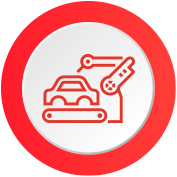Customers Quality Management
Having fully satisfied customers is the goal of any company that wants to perpetuate itself in the market. The Customer Quality Management Suite is primarily aimed at delivering defect-free items through the approval of initial samples (PAPP) and then identifying and eliminating the causes that caused problems in customers, whether they arise from production processes or items received of the supply chain.
SIQ Customers Quality Management Suite is composed of the following modules:
-
Initial Samples Approval Process for Customers
Management of the development of projects, NEW or MODIFIED, from the issuance of the Request (integrated to the Engineering Document) to the receipt of PPAP. Control of schedule, responsible, deadlines, actions, agreements, results and Status of each project.
-
Products in Warranty
Manage customer complaints by automatically generating stock and cost needs.
-
Non Conformities
The main objective of the Nonconformities module is to identify and completely eliminate all existing Non-Conformities, minimizing undesirable situations with the application of Corrective Actions and Preventive Actions, always focusing on the Continuous Improvement of activities. The module directs users to a methodology for solving nonconformities, according to the method applied by the company, as: 8D, 5PB’s, Ishikawa Fish Diagram, among others, these methods being established according to the client’s preferences.
-
Non Quality Cost
Identify all the costs associated with Poor Process Quality in order to align quality and goals in order to promote a more efficient use of resources, allowing the work to be done correctly every time it is done.
-
Asset Management, Tooling and Measuring Equipment
The purpose of this module is to control all existing assets, tools and measurement equipment in the company, offering greater reliability and agility in the use of information and providing managers with better planning of CAPEX and OPEX:
- Assets:
- monitoring and tracking of assets and their activities throughout their useful life, informing the need to carry out routine, preventive and / or corrective maintenance. You can control all asset-related documentation centrally, improving the visibility of information by the people in the organization.
- Tooling:
- tooling control, mainly the values of these assets, their location, useful life and technical conditions, which allows a better budget planning for the next periods, taking into account the item’s demand and tool construction time.
- Measurement equipment:
- it provides managers with a complete history of all equipment calibration information, including the date of last calibration, previous calibrations, as well as dates of maintenance and repairs.

